Black History, Publishing
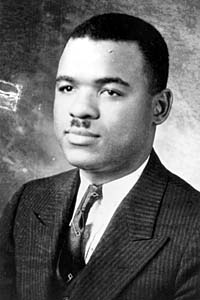
William Alexander Scott II
William Alexander Scott II came to Atlanta to receive an education and ended up, at the tender age of 26, founding a newspaper that would become the first successful African-American daily in the nation. The son of a minister, Scott did not allow the presence of another Black newspaper, The Atlanta Independent, to deter him from starting the Atlanta World on Aug. 5, 1928.
The publishers of the Atlanta World have felt the need of a Southern Negro Newspaper, published by Southern Negroes, to be read by Southern Negroes, Scott wrote in the first issue. By 1930, the newspaper was one of the most widely circulated Black papers in the South. Using the Atlanta World as fuel, Scott charged ahead, establishing the first chain of African-American newspapers in 1931. The Scott Newspaper Syndicate eventually would include 50 newspapers. On March 12, 1932, Scott achieved another goal when the Atlanta World went daily. (more…)
Black History, Publishing
In 1879, John James Neimore established The Ca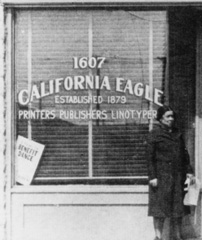 lifornia Owl as a means to help ease the black settlers’ transition to the western way of life. The Eagle provided many disparaged settlers with job, housing, and information on local charities.
lifornia Owl as a means to help ease the black settlers’ transition to the western way of life. The Eagle provided many disparaged settlers with job, housing, and information on local charities.
When The California Eagle shut down its presses in 1964, it was one of the oldest black-owned and operated papers in the United States. John James Neimore had established it in Los Angeles as The California Owl in 1879, to ease black settlers’ transition to the West. The paper provided them with housing and job information, and other information essential to surviving in a new environment. (more…)
Black History, Publishing
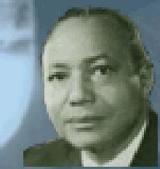
Robert H. Sengstacke
Sengstacke was born November 25, 1912, in Savannah, Georgia. He was singled out by his uncle, Robert S. Abbott, publisher of The Chicago Defender, and trained as his successor. Abbott financed his nephew’s education at Hampton Institute, where he graduated in 1934.
Abbott also subsidized his studies at the Mergenthaler Linotype School, The Chicago School of Printing, Northwestern University, and Ohio State University. In 1934 Sengstacke became Vice President and General Manager of The Robert S. Abbott Publishing Company, and served as its president, following Robert S. Abbott’s death in 1940. (more…)
Black History, Publishing
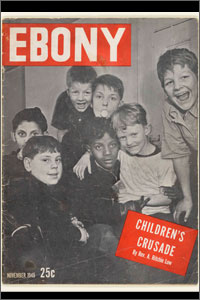
The first issue of Ebony magazine, Nov. 1, 1945.
On Nov. 1, 1945, America got its first look at Ebony, a monthly coffee-table magazine modeled after Look andLife but whose goals were to focus on the achievements of blacks from “Harlem to Hollywood� and to “offer positive images of blacks in a world of negative images.�
Founded by publisher John H. Johnson, Ebony’s first cover ironically did not feature a glamorous black entertainer or an African-American “first� but seven boys — six of them white — from a program to improve race relations. The first issue sold out at 25, 000 copies. Circulation peaked at nearly 2 million in 1997.
In addition to the fashion and beauty stories that continue to be Ebony mainstays, the magazine also tackled civil rights, education and black entrepreneurship, stories important to the black community that mainstream publications often ignored.
Through the lens of longtime Ebony photographer Moneta Sleet who died in 1996, Ebonywas at the forefront of some of the most important stories in history. (more…)
Black History, Publishing

The afro-american newspaper
The Baltimore Afro-American, commonly known as The Afro, is a weekly newspaper published in Baltimore, Maryland, USA. It is the flagship newspaper of the Afro-American chain and the longest-running African-American family-owned newspaper in the United States
The newspaper was founded in 1892 by a former slave, John H. Murphy, Sr., who merged his church publication, The Sunday School Helper, with two other church publications, The Ledger and The Afro-American. The publication began to rise in prominence when, in 1922, Carl Murphy took control and served as its editor for 45 years. There have been as many as 13 editions of the newspaper in major cities across the country; today there are just two: one in Baltimore, and the other in Washington, D.C.
Black History, Publishing
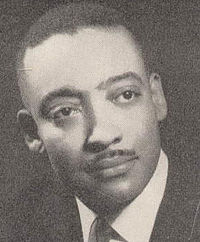
Louis E. Lomax
Born in Valdosta, Georgia. Educated at Paine College in Augusta, graduating in 1942, and later at American University (M.A., 1944), and Yale (Ph.D., 1947). Taught philosophy briefly at Georgia State College in Savannah.
Worked as a newspaper reporter, for Baltimore Afro-American and Chicago American, until 1958; later a freelance magazine journalist and author of books including The Reluctant African (1960), The Negro Revolt (1962), When the Word Is Given: A Report on Elijah Muhammad, Malcolm X, and Black Muslim World(1963), Thailand: The War That Is, The War That Will Be (1967), and To Kill a Black Man (1968).
In 1959, with Mike Wallace, interviewed Malcolm X for documentary on Nation of Islam, The Hate That Hate Produced. From 1964 to 1968 hosted twice-weekly Los Angeles television show on KTTV; lectured widely on college campuses. Died in automobile accident near Santa Rosa, New Mexico.





